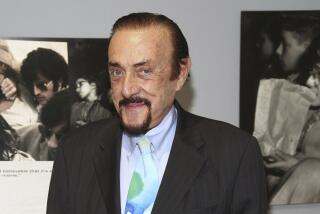BOOK REVIEW / SCIENCE : In Search of the ‘Little Man’ in the Brain : THE ASTONISHING HYPOTHESIS: The Scientific Search for the Soul, <i> by Francis Crick</i> , Scribner’s; $25, 317 pages.
- Share via
Francis Crick wants to know where “you” live. He isn’t interested in the name of your street, nor in the color of your skin, nor even in the nature of your genes, which he, along with James Watson, helped discover in the 1950s.
His “Astonishing Hypothesis” is that “you--your joys and your sorrows, your memories and your ambitions, your sense of personal identity and free will--are in fact no more than the behavior of a vast assembly of nerve cells and their associated molecules.”
And he wants to know the precise location in your pudding-textured brain of the cells that assemble “you.”
Truth be told, while most of us are not likely to warm to the hypothesis that we are little more than pudding, few scientists today would call it astonishing.
Descartes’ dualist theory of a separate mind and body began unraveling in the Renaissance, when physicians realized that such earthly afflictions as strokes could radically alter the spirit. It has all but collapsed in recent years, as scanning technologies with such spunky acronyms as PET and SQUIDs have localized the brain metabolisms that lead to feelings like sorrow and joy.
Nevertheless, it’s one thing to localize and another to understand, and the hard truth is that even persevering and punctilious researchers like Crick have so far been unable to find a central core of being.
Neuroscientific thinkers seemed able to contain their frustration until 1991, when an audacious philosopher named Daniel Dennett published a book called “Consciousness Explained” (Little, Brown), in which he argued that there was no such core, no “homunculus” or “little man in the brain” who dutifully assembles our sense of self.
The book managed to directly insult Crick, who goes on in these pages to attack Dennett and other leading consciousness theorists, from Roger Penrose (“The Emperor’s New Mind,” Penguin, 1989) to Gerald Edelman. In turn, Edelman, in his 1992 book “Bright Air, Brilliant Fire” (Basic) has criticized Crick, scoffed at Dennett (“His is not a theory of consciousness”) and dismissed Penrose: “He’s in over his head.”
The battles seem less evocative of the elegant Salk Institute in La Jolla, where Crick works by the sea in an office designed by Louis I. Kahn, than of a place several miles south: the Primate Wing of the San Diego Zoo. And no wonder, for it can be argued that since cerebralism makes humans Top Primates, the person who comes to understand that cerebralism gets to be the Top Primate.
As in most battles, though, the warriors turn out to hold views that are more similar than they care to admit.
Crick begins this book by staking out a position antithetical to Dennett’s: “There must be structures or operations in the brain that in some mysterious way behave as if they correspond somewhat to the mental picture of the homunculus.”
But he ends by endorsing a notion similar to Dennett’s “Multiple Drafts Model of Consciousness,” wherein there is no single homunculus.
*
Similarly, probably out of annoyance at the legions of glib popularizers who analogize the brain to a computer, Crick snaps that “a brain does not look even a little bit like a general-purpose computer.” But he ends up contending that computer-simulated “neural networks,” while “far removed from the complexities of the brain,” may indeed provide the key to understanding the brain’s behavior.
(As Isaac Asimov pointed out in a 1967 article, computers are “far removed” from the brain largely because they are less complex: A modern, neural-networked computer may have fewer than 20,000 on-off connections, for instance, whereas the brain has about 100 billion cells with 100,000 billion highly complex connections.)
So if the ideological differences between Crick, Dennett and others are not dramatic, then why are their battles so heated? Because there is little agreement on where neuroscience should go from here.
At one end of the spectrum stand wildly speculative theorists such as Penrose, who says the answers may lie in physics. Crick’s criticism of Penrose is unsparing but accurate: “At bottom, his argument is that quantum gravity is mysterious and consciousness is mysterious and wouldn’t it be wonderful if one explained the other.”
At the other end of the spectrum are researcher’s researchers, such as Crick. Crick’s description in these pages of a more scientific approach to studying consciousness--one that attempts to connect today’s billowing, abstract theorizing to hard chemical evidence--may prove daunting to some lay readers. But Crick himself is never intimidating.
On the contrary. Arguing that science cannot progress without laypeople like you and me asking basic, even stupid questions, he begins one chapter with this quote from economist Vilfredo Pareto:
“Give me a fruitful error any time, full of seeds, bursting with its own corrections. You can keep your sterile truths for yourself.”






